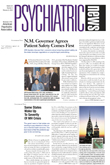The concept of community mental health centers (CMHCs) has been an important part of discussions about how to provide mental health services at least since 1960, when the federal Joint Commission on Mental Illness and Health proposed one “fully staffed, full-time mental health clinic” for each 50,000 of population.
In that year, the Democratic Party voted at its convention in favor of a plank in support of “greatly increased federal support for psychiatric research and training and community mental health programs to [help hospitalized mentally ill live in communities].”
President John F. Kennedy attempted to fulfill that campaign promise with the appointment of a National Institute of Mental Health (NIMH) study group, which recommended “comprehensive” CMHCs offering inpatient, outpatient, and rehabilitative services, as well as education and public information.
A coalition of mental health organizations supported a Kennedy proposal for CMHCs that would have provided funding for construction of CMHCs and limited staffing grants.
Congress approved the construction costs but not the staffing grants until President Lyndon B. Johnson requested them with legislation, the Community Mental Health Centers Act Amendments, which passed in 1965.
The NIMH mandated that CMHCs were to provide five essential mental health services: inpatient, emergency, partial hospitalization, outpatient, and education.
Henry Foley, Ph.D., and Steven Sharfstein, M.D., wrote in Madness and Government (APPI, 1983), “In the beginning, then, CMHC services plus those of the state hospitals theoretically represented a balanced array, but the CMHC program alone did not. . . . The unanticipated consequence. . .was the failure of most CMHCs to develop even minimal rehabilitation and aftercare services for the mentally ill being discharged or diverted from state hospitals.”
In 1972 President Richard M. Nixon argued that federal support for the CMHC program should be phased out and replaced with local support.
Instead, in 1975 with new legislation, seven new services were added to the definition of “essential service.”
“The enactment of PL 94-63 in July 1975 over a presidential veto climaxed a seven-year struggle for program survival, which included appropriation battles and impoundment suits,” wrote Foley and Sharfstein.
By 1977, 650 CMHCs had been funded, covering 43 percent of the population and serving 1.9 million people that year. The $1.5 billion federal investment generated another $2.5 billion in other sources of funds.
In 1977, however, the average length of stay for a patient in a state hospital was three weeks, down from six months in 1955.
“The bold new CMHC approach had little time and too meager resources to test its mettle before being overtaken. . .by the urgent needs of patients with chronic mental illness,” wrote Foley and Sharfstein. In 1977, President Jimmy Carter established the President’s Commission on Mental Health, which ultimately made more than 100 major recommendations and findings.
After considerable debate within the administration, Carter submitted the Mental Health Systems Act to Congress in 1979, where it was subjected again to much debate.
“The primary mission of community mental health has been disputed since the beginning: the Systems Act forcefully restated each of three missions without resolving priorities,” according to Foley and Sharfstein.
The missions are adequate clinical care, particularly for those with serious mental illness; supportive services; and prevention.
President Ronald Reagan, who was elected in 1980, recommended that Congress cut the level of funding for the act by 25 percent and convert it into a block-grant program.
In August 1981 he signed the Omnibus Budget Reconciliation Act, which “substantially repealed the Mental Health Services Act. . . . The federal government was entirely removed from the direction of the program and became a mere conduit of funds to the states.” ▪
